Report

Executive Summary
- Leakage of customers’ business to competitor banks, fintechs and single-line specialist companies is rampant, yet often hidden because many consumers still keep an account with their primary bank.
- Stemming the hidden defection will require banks to develop more appealing core products and propositions, along with seamless digital operations that resolve a customer’s need the first time.
- Right-first-time digital episodes cost far less and earn greater loyalty, our global survey of 131,930 consumers shows. New NPS Prism℠ analysis reveals the operational factors within an individual episode that drive loyalty.
- Most respondents are open to using their bank for related services, such as running a micro business, through an ecosystem of partner providers.
Retail banks continue to leak their customers’ business. While the spread of digital experiences and sales channels has been a boon for consumers, most traditional banks still lag the digital experience offered by leading fintechs, established single-line companies and major technology companies. As a result, nonbank competitors have been steadily poaching customers in a variety of banking products.
Hidden customer defection is rampant, Bain & Company’s latest survey of 131,930 consumers in 22 countries shows. The outflow will only get worse for banks unless they significantly improve and digitalize the customer experience and supporting backstage operational processes, thereby taking out cost to reinvest in better offerings for consumers.

Defection has been hidden to some extent by consumers who maintain a current (checking) account with their primary bank, due to inertia or the reassurance of government guarantees that their funds will be safe. Meanwhile, those same people often obtain their next product from competitor banks and nonbanks for credit cards, mortgages, loans and funds transfers. Established specialist companies, such as Discover and Rocket Mortgage (by Quicken Loans) in the US, have aggressively invested in digital channels and processes, and in many cases lead in customer loyalty as measured by Net Promoter Score®.
Some younger companies, meanwhile, are moving into the mainstream. In India, 75% of respondents used Paytm in the past year, and in China, 70% used Alipay. To understand why, consider Grab and Gojek, which are the Ubers of Southeast Asia and have been using the payments function to build out broader ecosystems for their “super-apps.” Singapore-based Grab offers food delivery, hotel booking, video, ticketing and travel services. Gojek, based in Indonesia, has built a suite of services around its core two-wheeler transport system, including food and parcel delivery, ticketing, moving and cleaning. These firms have entered payments and banking because they saw unmet needs among customers. They don’t expect to make a profit in payments, operating instead under the assumption that eventually they will charge little, or even nothing, to the end consumer or merchant for the payments function.
For many such digital disrupters, the current stock of customers may be low compared with traditional banks’ customer base, but the flow is huge. Among all UK respondents, the share is low for challenger banks Revolut, Monzo, Starling and Monese, but for respondents who opened a new checking or savings account in the past year, the share doubles. For younger respondents who opened an account, the share increases by four times (see Figure 1). Likewise, while only 2% of US respondents use Rocket Mortgage, the company enjoys a 17% share of the total mortgage outflow from customers’ primary bank—several percentage points higher than the established major banks. In other words, the disrupters and product specialists are parlaying their greater customer loyalty to punch well above their weight in attracting new business.
Consumers, especially younger ones, are rapidly adopting products by challenger banks


These disrupters attract consumers with not only simpler, more appealing digital interfaces, but also customer-friendly product features and pricing. For example, Revolut, a fast-growing fintech based in the UK, offers currency exchange and peer-to-peer payments, using the existing payments infrastructure behind its prepaid debit card. It charges no fees for most of its services (though with capped usage) and uses interbank exchange rates for its currency exchange on weekdays, far below the rates and fees charged by traditional banks. Revolut has already signed up almost eight million customers in the UK, and recently launched a beta version in Australia amid regulatory criticism of incumbent banks’ opaque currency-exchange fees.
How to stop the leakage
Stemming hidden defection will require banks to develop seamless digital operations that resolve a customer’s need the first time, without forcing the customer to resort to a phone call or branch visit. One of the key battlegrounds is sales. For the first time, our analysis of data from Bain’s NPS Prism benchmarking tool—which compares consumer perceptions of competing banks at the detailed level of an individual episode, such as “apply for a new credit card”—shows how delighted consumers can be with a fully digital sales process.
Consumers increasingly use online and mobile channels for research and purchasing. The share of product purchases via digital channels ranges from 18% to 60%, depending on the country, a rise of 2 to 16 percentage points since 2017.
Mastering digital channels pays off with greater loyalty. The value of digital channels becomes clear after analyzing individual episodes, which are tasks that a customer must complete or needs to fulfill through the bank. At USAA, which is the loyalty leader for checking or savings accounts, respondents give a higher Net Promoter Score to a straight-through digital sales process than to one requiring assistance from a contact-center agent. In the UK, Royal Bank of Scotland developed a paperless mortgage product and now uses the paperless process for 91% of new mortgages. This eliminated 66 pages of paperwork and reduced the time to close from 23 days to 11 days—which saved costs, improved the Net Promoter Score by 30 points from the paper process and raised revenues by reducing leakage of customers.

How Banks Can Stop Hidden Defections
Traditional banks are losing customers to digital insurgents and may not even know it. Here's how banks can fight back.
By contrast, unnecessary human intervention can lead to longer completion times or introduce errors, which frustrate customers. When banks improve backstage operations through digital technologies, the cost savings not only make a better experience, they usually allow banks to fund better offerings. Cutting costs on foreign-currency transactions, for instance, would help banks reduce their fees and compete against fintechs in that market.
Uncovering the operational causes of loyalty
Some leading banks that are redesigning a particular episode have first surveyed consumers about the details of the episode and how the bank’s performance stacks up against competitors. NPS Prism analysis at 20 major traditional US banks illustrates the point. For the “open a checking account” episode, a digital, right-first-time version has by far the lowest cost to complete, and has a Net Promoter Score of 62. However, only 11% of customers experience this. Some 48% of customers also used human assistance, which has a much higher cost and a lower loyalty score of 54. Worse, one-fourth of customers went through an employee-assisted version that did not go right the first time, at the highest cost and an even lower score of 31 (see Figure 2).
Digital self-service that resolves an issue the first time costs less and appeals to customers


Further, the survey probes operational and policy questions, such as whether the fee charged for the episode was reasonable, whether customers found it easy to complete or how much time it took. A bank can unpack each stage of the process to determine where it performs better than its direct competitors and industry leaders, and where it falls short. By uncovering such detailed information about each stage, the analysis identifies which areas need targeted investments in order to improve the episode and help a bank earn greater loyalty.
Banks will want to reduce the incidence of episodes likely to annoy consumers, such as disputing a fee or having a card declined at the point of sale (see Figure 3). These episodes usually involve contact-center agents, which raises labor costs, and respondents who go through the episodes give a lower overall Net Promoter Score for the bank. Loyalty-leading banks typically have fewer such episodes (see Figure 4). Their customers are more likely to use digital first, more likely to experience first-contact resolution and less likely to experience a failed digital transaction than customers of the loyalty laggards—all conditions that lead to lower costs (see Figure 5).
Certain banking episodes are more likely to annoy customers


Banks that lead in loyalty usually have fewer of the annoying episodes


Loyalty-leading banks tend to excel in reliable digital channels and tools for customers


All of these cost benefits, moreover, come on top of the large boost to revenues. Customers who are promoters of their bank own more products there than detractors do; they spend more on their primary credit card; and they are more likely to buy the next product from the primary bank, which means they are less likely to defect to competitors.
Yet even banks with relatively strong customer loyalty cannot take that asset for granted. The emergence of challenger banks and specialist companies may be changing the dynamics of some markets, in that younger customers are willing to try these alternatives, given how easy it is to do so.
Bring on the ecosystems
If banks focus on fully meeting consumers’ financial needs, they inevitably will have to develop a broader ecosystem of partners and suppliers. Done right, that could lead to tapping new profit pools.
Fortunately, consumers are open to using their bank for related services through an ecosystem of providers. Across countries, survey respondents show the greatest interest in one-stop shopping for personal credit, managing personal finance and running a small business. Interest is highest in developing markets such as Mexico and India, where consumers have often leapfrogged from traditional methods to the latest mobile incarnations.
Some banks have made a promising start. In the UK, NatWest launched Home Agent, a digital platform that connects first-time home buyers with partners providing property valuation, utility deals, moving services, cleaning services and general contracting. Capital One in the US offers online vehicle listings and tools to immediately prequalify car buyers for financing, while DBS in Singapore runs the largest direct seller-to-buyer car marketplace in the country.
Interest in ecosystems is also high among customers who work as solo practitioners or own a very small business. These people often spend a lot of time navigating separate platforms for banking, enterprise resource planning, human resources and payments. Banks can help contain the sprawl by devising a simple, easy-to-use package that integrates these functions. A major concern voiced by micro firms, in our experience, is the complexity of moving among systems for payments management, accounting, human resources and bank transactions. This suggests substantial unmet demand for a one-stop shop through a truly integrated system. That motivation, for instance, explains why Danske Bank in Denmark launched District, a small-business platform that integrates third-party services such as cloud payroll provided by Zenegy. Small-business customers can link their cloud-based accounting systems to the platform and view their accounting and HR data there.
As more digital banking licenses are granted in markets such as Hong Kong and Singapore, and as fintechs and large technology companies continue to expand into banking domains, we could see a new wave of alternative business models take hold. Citi, for example, projects that anywhere from one-third to one-half of total payments volumes and investment volumes could go to disruptive models by 2025. In response, robust ecosystems could help traditional banks close the loyalty gap with challenger banks and fintechs. Executives considering new or expanded ecosystem strategies should address a few key questions:
- Which ecosystems are appealing to customers in our market and gaining commercial traction?
- What types of partnerships have been most valuable to us already? What makes a good partner? And what does it take to be a good bank partner?
- How proven is the economic model?
- How would we manage the ecosystem—as a new line of business or some other format?
- How would we manage the commercial, reputational, cyber, data and brand risks?
- What technology would we need to develop or implement?
Whatever the product or country, banks that accelerate their “simple, digital, right-first-time” operations can remove the drudgery and inject more delight into customers’ overall experience. Reducing the costs of their key episodes also frees up funds to reinvest in better propositions that meet customers’ needs at competitive prices. Only then can banks stem the rising tide of defections.

1. Loyalty continues to generate favorable economics
- Earning greater loyalty from consumers yields major benefits for banks. Certain episodes, such as disputing a fee, tend to annoy customers and also often require human channels, making them more costly. The loyalty leader banks have dramatically fewer of these episodes.
- Customers of a market’s loyalty leader are more likely than those of the loyalty laggard to use digital channels first, more likely to resolve an issue at first contact and less likely to have the digital channel fail to resolve the issue. All these conditions lead to lower costs.
- Loyalty also helps increase revenue. Customers who are promoters own more products at their primary bank than detractors do.
- Promoters recommend their bank to others nearly two to six times as readily as detractors. Promoters also say they are less likely to switch to a competing bank.
- In the UK, for instance, a higher Net Promoter Score correlates with more net current-account additions for a bank. Promoters are more likely to buy the next product from their primary bank than detractors.
- Another example: In the US, promoters spend about one-quarter more, on average, on their primary credit card than detractors do.
Certain banking episodes are more likely to annoy customers

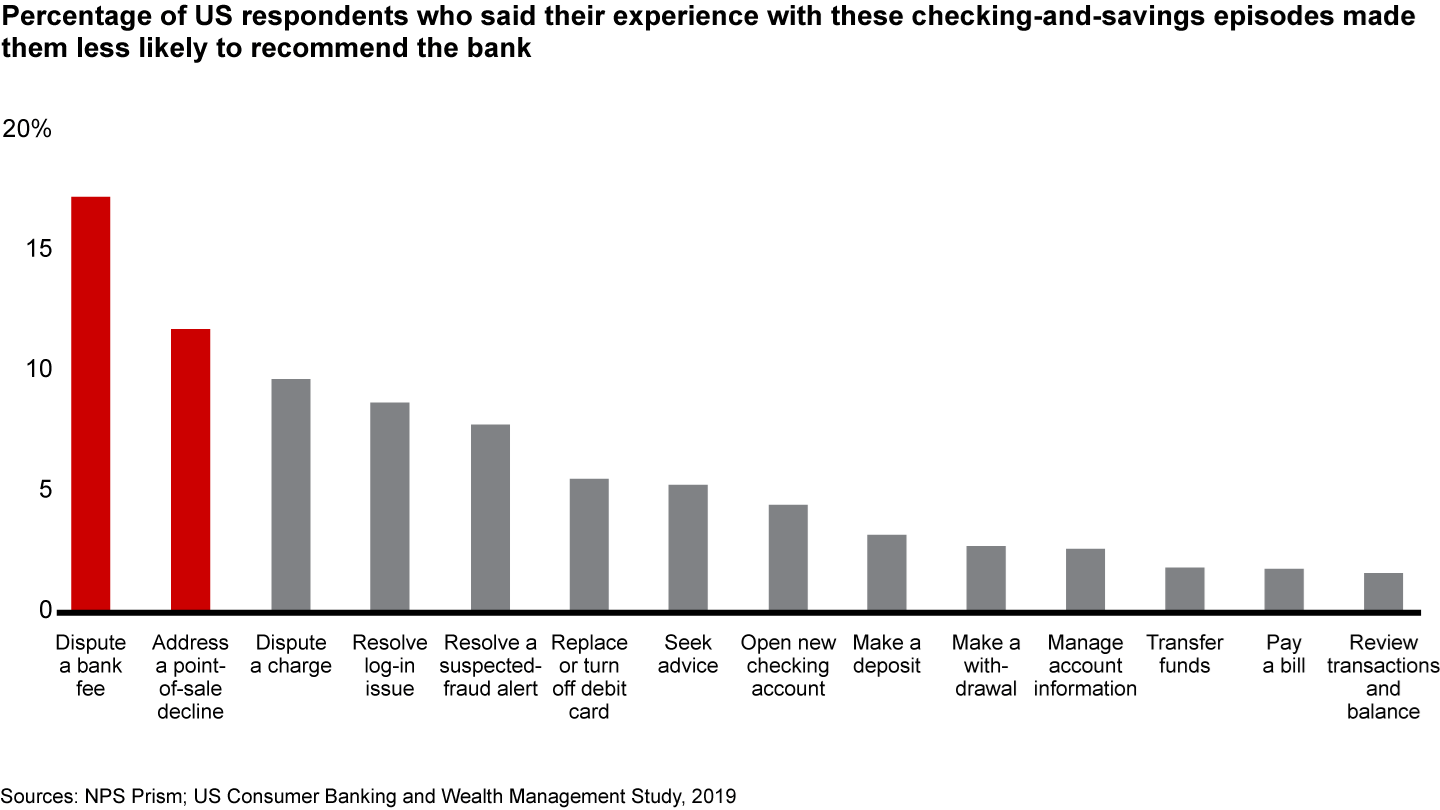
Banks that lead in loyalty usually have fewer of the annoying episodes


Many episodes often start through human channels, which are costly, and banks should work to avoid them in the first place

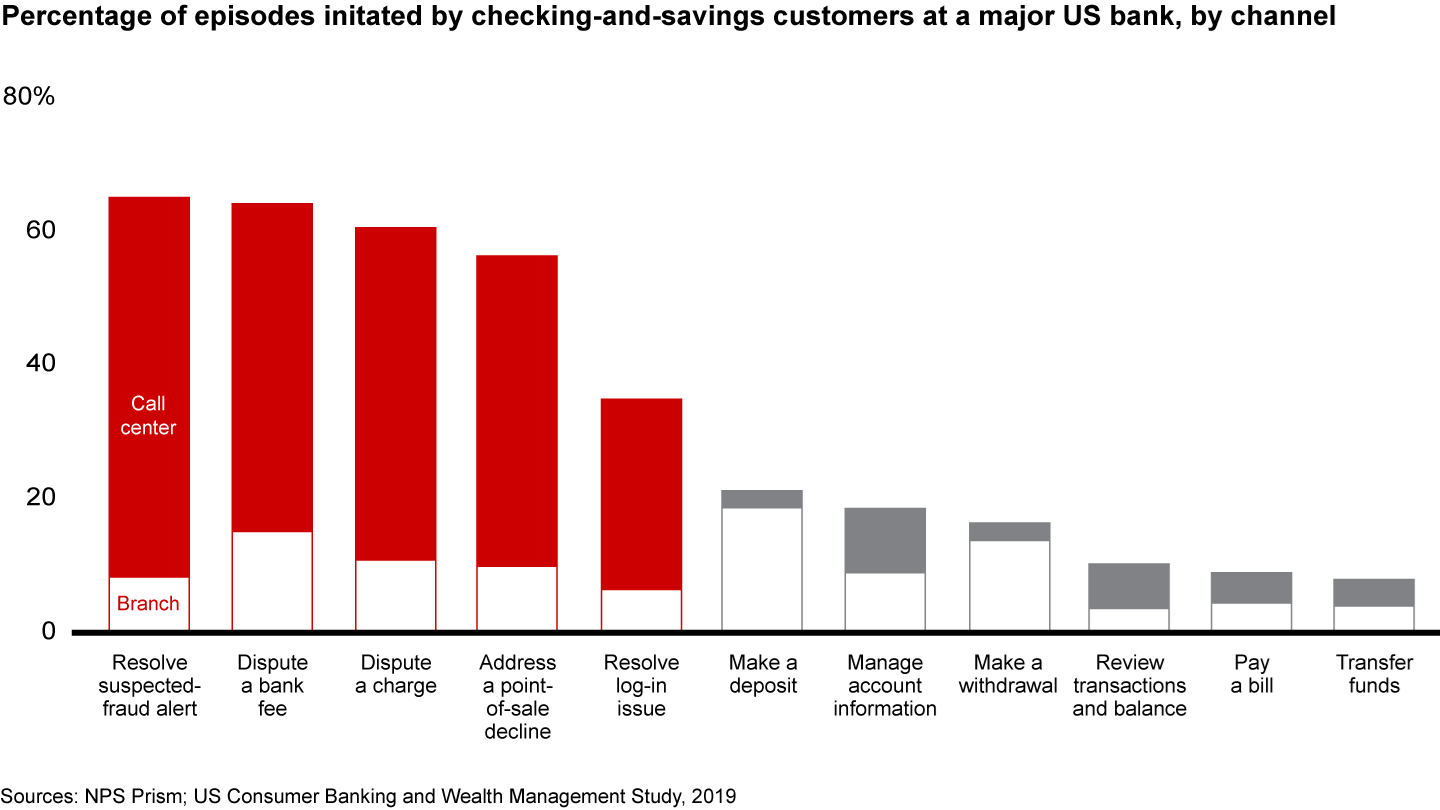
Loyalty-leading banks tend to excel in reliable channels and tools for customers


For making a deposit, reliable digital self-service costs less and appeals to customers


Customers who are a bank’s promoters recommend the bank to others as much as six times more than detractors


Detractors say they are more likely than promoters to switch to a competing bank


Banks with higher loyalty scores tend to achieve a greater net increase in current accounts


Promoters buy more products at their primary bank than detractors do


Promoters spend one-quarter more than detractors on their primary credit card


2. Sales are rapidly digitalizing, making it easier for customers to defect
- Digital channels have become a central means of selling banking products. From 41% to 67% of respondents, depending on the country, use digital to research products, and 18% to 60% of respondents purchase via digital. Both shares have risen significantly over the past two years.
- Digital is the main channel for hidden defection for many products. Customers, especially younger ones, mostly use digital channels when buying certain products, such as a credit card, from a competing bank.
- Further increasing digital usage will require improving the channels’ interface and functionality, as well as coaxing reluctant customers to change their behavior. From 14% to 29% of respondents researched products online, but ended up purchasing through human channels, depending on the country. Of those, 7% to 18% tried purchasing through digital channels and failed to do so.
- Many respondents say they prefer speaking to a person for the actual purchase or believe it cannot be done online. Banks will have to work hard to migrate this group to digital sales and will need some human interactions at key moments in order to raise purchase confidence and completion.
- Loyalty-leading banks excel at delivering smooth digital experiences and benefit from the higher loyalty scores that customers give digital-only over human-only episodes. That dynamic, however, varies by product: Respondents appreciate employee intervention and advice in purchase episodes for mortgages and wealth management, but not for checking or credit cards.
Customers increasingly use digital tools to research banking products

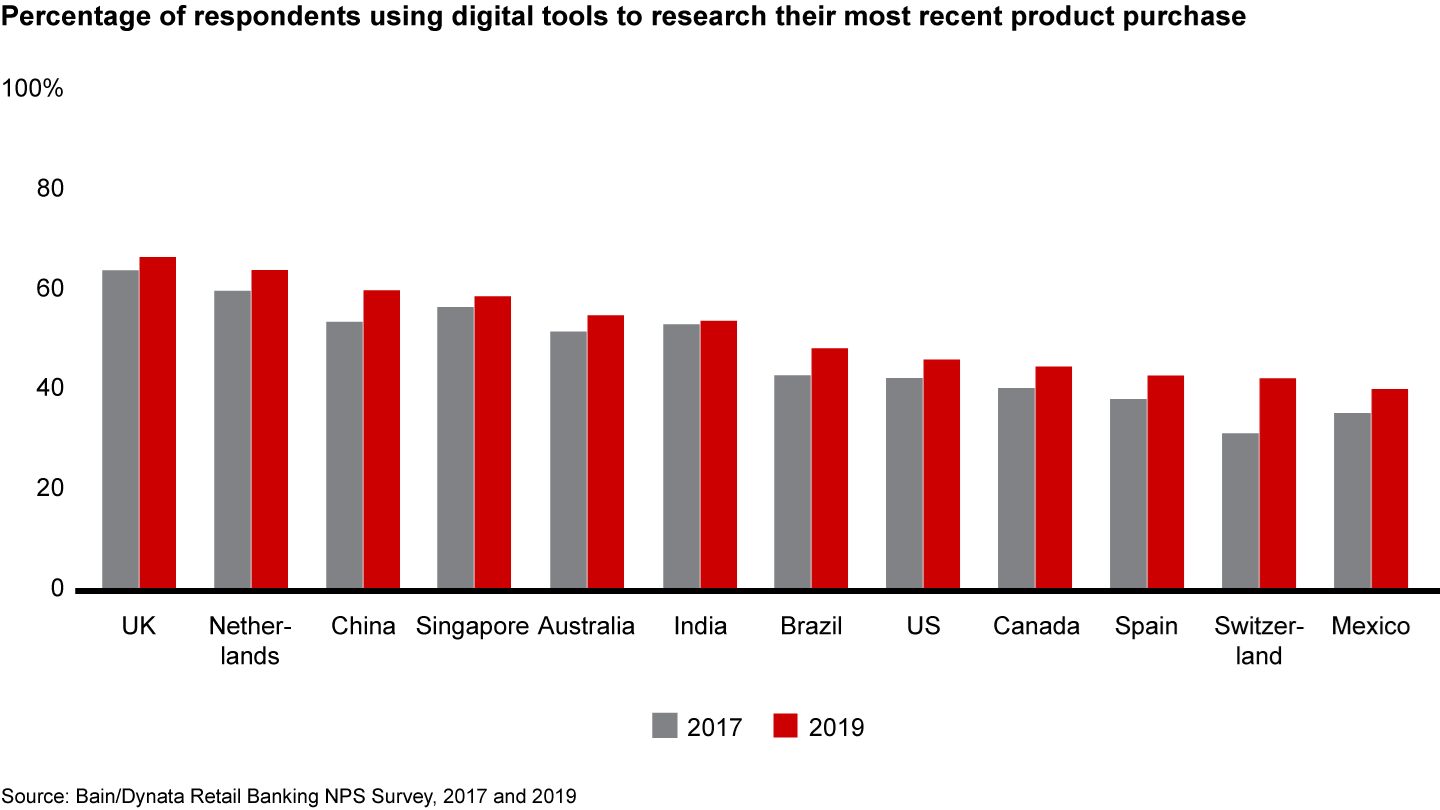
More customers are using digital channels to purchase banking products


The use of digital channels for both research and purchases is rising across product categories


When customers defect to another bank, a substantial share of them go through digital channels


A sizeable share of customers research banking products digitally, but purchase through human channels


Many banking customers who try purchasing through digital channels fail to complete the transaction that way


Many banking customers think it is easier to purchase through a human channel, or prefer to speak with an employee before buying a product


Loyalty-leading banks often excel at simple and easy digital processes, which attract customers


A digital-only purchase episode often garners greater customer loyalty than a human-only episode


Banks pay a penalty if customers are forced to switch channels for simple purchases

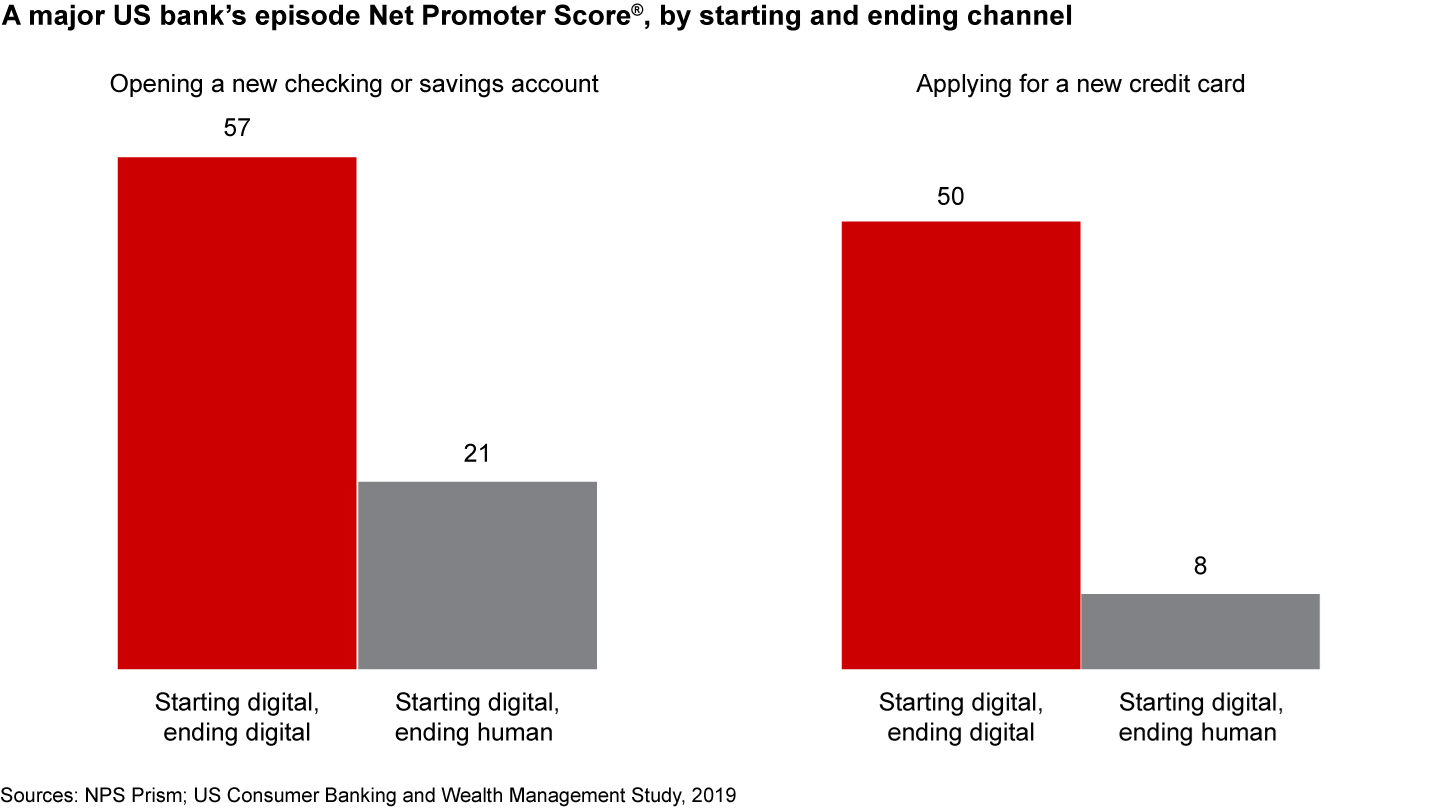
For complicated or emotional purchases, customers appreciate a dose of human advice and guidance


3. Technology companies still hold great appeal
- Willingness to buy a financial product from established or new technology companies remains high among respondents in many countries, especially in Asia and Latin America, though less so in many European countries.
- In all countries, younger people are even more willing to try banking with technology companies.
- Current use of technology companies’ offerings varies a lot from country to country. Nonetheless, we see risks for incumbent banks everywhere. In emerging markets, adoption rates have been high for many fintech disrupters, including Paytm in India, WeChat Pay and Huabei in China and DaviPlata in Colombia.
- In more mature markets, some disrupters are becoming mainstream. In Australia, 18% of all respondents and 31% of younger ones have used Afterpay in the last 12 months. And while only 7% of all respondents in Canada used Borrowell in the past year, the adoption rate among respondents who applied for a personal loan from Borrowell during that time was 16%, and 18% for younger respondents who applied for a loan. Furthermore, a long tail of smaller disrupters is gaining customers rapidly.
- Respondents give many of the disrupters a higher Net Promoter Score than they do the average traditional bank.
Customers in many countries would be willing to try banking with a technology company, especially an established one


Younger customers around the world are more open to banking with a technology company


Adoption of products from large technology companies is highest in emerging markets


Some fintechs are becoming mainstream in emerging markets


Certain fintechs are becoming mainstream in developed markets


Younger customers have been embracing fintechs more than the overall population


Fintechs hold a stronger appeal among people who recently bought a banking product


4. Ecosystems of related services draw strong interest
- Many consumers express interest in accessing services related to their banking product through an ecosystem provided by the bank, typically connected to third-party partners.
- Robust ecosystems could allow banks to tap new profit pools by addressing more needs of current customers, attracting new customers and improving the value-for-price equation.
- Consumers in emerging markets show the strongest interest in ecosystems, as do young consumers in every country.
- New home buyers in the UK, for example, can use NatWest’s Home Agent ecosystem for services ranging from moving to utilities deals to repairs.
- In most countries, a one-stop shop for small business services garners the greatest interest from respondents who own a related product, followed by personal borrowing and personal finance.
- Among retail customers who own very small businesses, there is substantial unmet demand for a simple, easy-to-use package that would integrate functions such as payments management, accounting, human resources and bank transactions.
An ecosystem of interconnected services can benefit both the bank and its customers


Interest in banking ecosystems is highest among younger customers and those in emerging markets


Several categories of related services, including those for small businesses, evoke strong interest among banking customers


NatWest’s Home Agent ecosystem in the UK integrates a range of home-related services

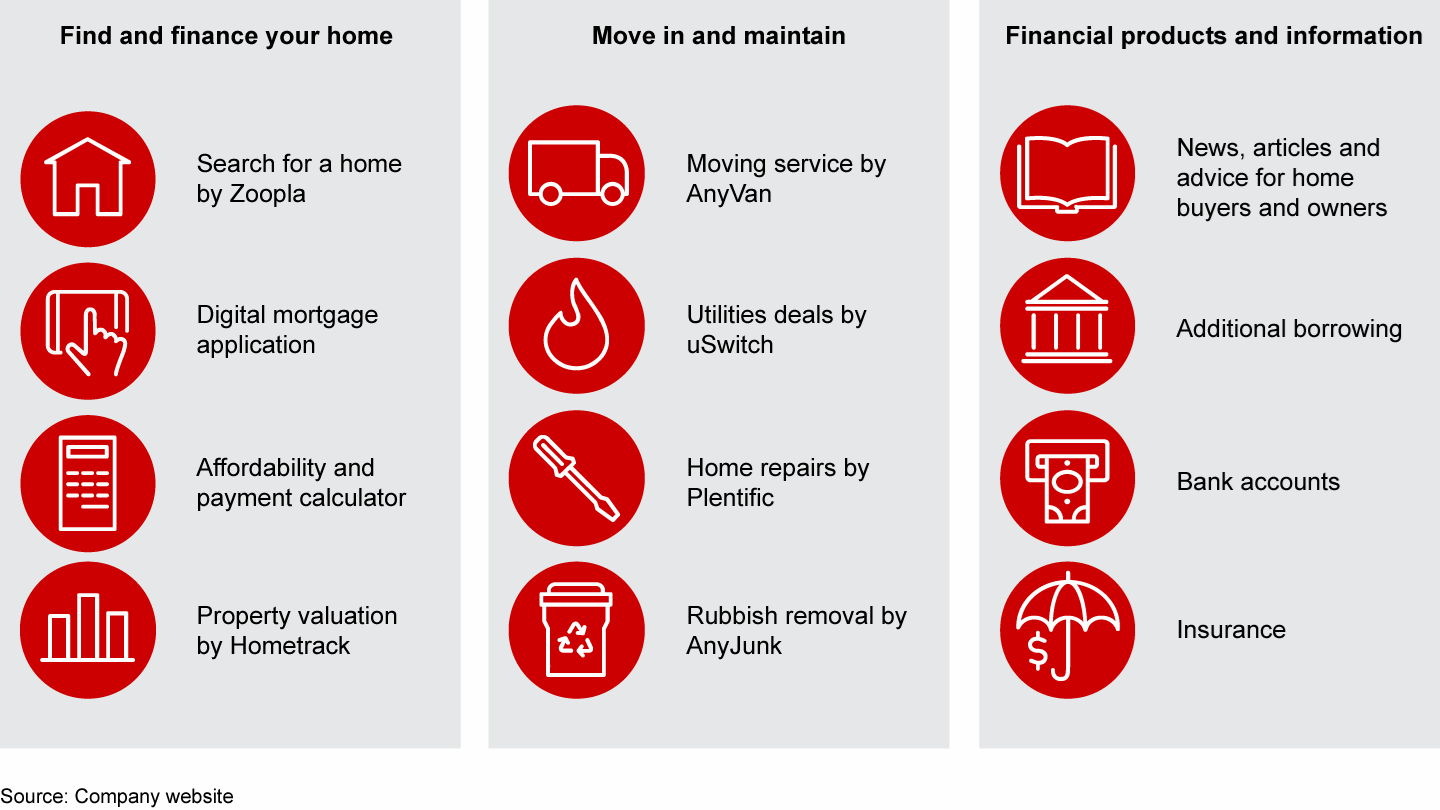
Appendix: Methodology
Survey questions
Respondents first were asked to identify their primary bank, then were asked the following questions to assess their loyalty to that institution:
- On a scale of zero to 10, where zero represents “not at all likely” and 10 represents “extremely likely,” how likely are you to recommend your primary bank to a friend or relative?
- Tell us why you gave your primary bank the score you did.
Ratings of zero to 6 signify detractors, 7 and 8 signify passives, and 9 and 10 signify promoters. A Net Promoter Score is calculated by subtracting the percentage of detractors from the percentage of promoters. A positive score indicates advocacy and support, while a negative score shows the opposite.
We asked what major products respondents hold with their primary bank and with other banks, and which of these products were purchased in the past year. We also asked respondents what their most recent purchase had been, and which bank and channels they used to make this purchase. Further, we asked how often they interacted through various channels to do their banking in the past three months. We asked questions about respondents’ attitudes toward using technology companies for financial products, and whether they had used specific big tech or fintech companies recently. We also asked respondents about their openness to using a “one-stop shop” of related services provided by their bank. The remaining questions elicited demographic profile information: household income, investable assets and region of residence.
NPS Prism
We also relied on data from NPS Prism’s US and Canada Consumer Banking and Wealth Management Studies. NPS Prism is Bain’s subscription-based online benchmarking service that employs rigorous, double-blind research. NPS Prism provides access to tens of thousands of NPS responses at a relationship, product and episode level, as well as a multitude of operational metrics. These customer experience benchmarks allow comparison to competitors on the specific interactions that shape the customer experience.
Acknowledgments
This report was prepared by Gerard du Toit, Katrina Cuthell and Stanford Swinton, partners in Bain’s Financial Services practice; Christy de Gooyer, a practice director; and a team led by Sonal Chawla and Arti Gupta. Team members were Vasu Agarwal, Sunvi Aggarwal, Richa Gambhir, Sahiba Gambhir, Neeraja Krishnadas and Yogendra Patel. The authors thank Bain partners in each of the countries covered in the report for their valuable input and John Campbell for his editorial support.
Bain & Company partnered with Dynata, an online global market-research organization, to survey consumer panels in Australia, Belgium, Brazil, Canada, China, Colombia, France, Germany, Hong Kong, India, Ireland, Italy, Mexico, the Netherlands, Poland, Singapore, South Korea, Spain, Sweden, Switzerland, the UK and the US. The survey’s purpose was to gauge customers’ loyalty to their principal bank and the underlying reasons customers hold their views. Conducted from July to September 2019, the survey polled 131,930 respondent consumers of national branch network banks, regional banks, private banks, direct banks, community banks and credit unions in these markets.
Net Promoter System®, Net Promoter Score®, Net Promoter® and NPS® are registered trademarks of Bain & Company, Inc., Fred Reichheld and Satmetrix Systems, Inc.
NPS Prism℠ is a service mark of Bain & Company, Inc.

About the Research
Data powered by Dynata, a leading global first-party data and insights platform.